"Summits On The Air" with W7MRC, Amateur Radio, Rhodesian Ridgebacks, Field Craft, Living in Montana, Old 4 Wheel Drivers, Mountain Bikes, Hiking and "Just Getting There"
Thursday, November 30, 2023
Escapod Topo 2 Overland Trailer :: Field Tested by Scott Brady

Teardrop trailers are old-school cool, with a lineage that dates back to the DIY plans of the 1930s. The trailer style has remained popular ever since, and for a good reason—they just work. The teardrop perfectly balances compact dimensions, sleep-inside comfort, and timeless style. Most small trailers use a rooftop tent for sleeping, but it isn’t easy to justify the expense when you can (in most cases) mount the same tent to the top of the vehicle. Teardrops earn their keep because of the quiet, four-season, secure sleeping pod they provide, and few teardrops match the Escapod Topo 2 for delivering on that promise.
Escapod was born out of necessity and became the American dream for co-founders Jen and Chris Hudak. Like many great company stories, it started with a passion for the outdoors, professional talents, and going all-in on their vision. They started Escapod by building the trailer they needed and discovered that others needed one just like it. This demand resulted in rapid design iteration, with the first units constructed in “mom’s garage.” They evolved from that home setup to a 20,000-square-foot facility in Coalville, Utah, where they manufacture the Topo 2 and manage their rental trailer fleet.


A few features make the Topo 2 unique, starting with the single-piece composite body with an infused structural polyethylene terephthalate (PET) core. It retains the classic teardrop shape but utilizes all the best engineering technologies to maximize strength and insulation. The unit body is strong enough to allow for 300 pounds to be removed from the galvanized chassis (as compared to competitors), allowing the Escapod to come in at an impressive 2,000 pounds fully equipped. The trailer weight makes it ideal for Jeep Wranglers and smaller crossover vehicles. The low tongue load and overall unit poundage benefit any tow vehicle, complemented by the aerodynamic shape.
Unless there is no other choice, avoid the rooftop tent on the trailer at all costs, as it removes nearly all of the efficiency benefits of towing a teardrop and adds weight and leverage in the worst possible location. What makes a tent on top an even worse idea is that any movement of sleepers in the tent or the trailer will wake the other party. Use an awning enclosure for kids, or have them sleep in the tow vehicle.
We towed the trailer with a 2023 Jeep Grand Cherokee Trailhawk 4Xe. Even loaded with gear, the weight did not materially affect 4WD performance, and the trailer is the optimal size for most remote backcountry use. We noted a 2.3 mpg impact on the economy, but that would be improved by ditching the rooftop tent. It was interesting to see how towing benefited the regen ability of the 4Xe Jeep, with slowing the mass helping to recapture some of the energy. There are some thoughtful details about the trailer for trail use, like the independent long-travel suspension with coilover, 32-inch diameter tires, 23 inches of ground clearance, and even the metal fender flares. Espcapod now offers rock rails, which protect the vulnerable front corners of the trailer body.



In camp is where the Escapod shines, and that is because the sleeping area is a literal shelter from the storm. Arizona had record winter storms during our testing, and the wind was howling. The Topo 2 is fully enclosed and insulated, with the Truma Combi unit (standard) for thermostatically controlled cabin heat and hot water. The trailer also includes rear stabilizer jacks to isolate suspension movement, all working in concert to give me a blissful night’s sleep despite the severe wind warning chiming on my phone. The queen-size mattress is 6 inches thick and flanked by mini mud rooms for storing (and heating) your shoes. The headboard is angled for lounging, concealing additional storage for long items like camp chairs. The interior also provides volumes of storage, with multiple drawers, cabinets, and cubbies for stashing personal effects. There is even a small media tray that supports a tablet for Netflix and, well, you know.
The kitchen is fully appointed and includes a stainless steel countertop, sink, and hot and cold running water. Twenty-one gallons of insulated water storage will allow cooking, cleaning, and showering for days. Storage also abounds in the galley, with integrated knife mounts, a utensil drawer, and various configurable cubbies for cooking sundries. The two-burner gas stove slides out but needs wind protection (at least on one side). Cold food storage is the standard 75-liter Yeti Tundra or an optional ARB 60-liter fridge/freezer. The table is clever, serving as a cover for the kitchen cubbies and then hooking to the fender flares for dining duty. An optional galley enclosure is available in bad weather or buggy regions.

The Topo 2 is well-appointed, even in standard form, but I found a few essential options to recommend. The first is their proprietary magnetic bug screen and privacy panel sets, as these panels are of impressive quality and add insulation and light blocking. The 200 amp-hour lithium-ion battery package and the ARB fridge/freezer are also worth fitting. The added power will allow for extended periods of off-grid camping and support the included solar panel. I would also recommend the electric trailer brakes and to match the bolt pattern on the tow vehicle (reduces the need for a trailer spare). Other attractive options are the Dometic AC unit and the 2,000-watt inverter. The trailer starts at $43,000 and is nicely equipped, but the options add up quickly, so knowing the ones we found most important might be helpful.
Overall, the Escapod Topo 2 is the most premium and high-quality teardrop we have tested, incorporating all of the critical features that make a trailer worthwhile. The Escapod is made in the USA by passionate travelers, and it shows, with gems like induction phone charging, a big nose box, and the ingenious dining table. Imagine what those DIY teardrop builders of the 1930s would think of the Topo 2; it’s the best of the past, present, and future.
$55,000, as tested | escapod.us
Editor’s Note: This article was originally published in Overland Journal’s Winter 2023 Issue.
Our No Compromise Clause: We do not accept advertorial content or allow advertising to influence our coverage, and our contributors are guaranteed editorial independence. Overland International may earn a small commission from affiliate links included in this article. We appreciate your support.
Milei Hates the State—Will It Be Enough? Milei represents a unique moment in the recent history of world leaders. by Peter Jacobsen
Javier Milei, the recently elected president of Argentina, is somewhat famous for his eccentric relationship with his dogs. There are a lot of quirks about Milei’s dogs, including the fact that they are literal clones (yes really), but most interesting to me is their names.
All the dogs are named after libertarians and/or economists. Most niche are his dogs Robert and Lucas named after the late economist Robert Lucas. His two other dogs are named Milton and Murrary for economists/libertarians Milton Friedman and Murray Rothbard, respectively.
These last two figures are interesting because, though they had much in common, Friedman and Rothbard were in an important sense adversaries.
In 1977, Rothbard wrote an article explaining why. His reason may be different than you’d expect. Rothbard was a committed anarcho-capitalist (similar to Milei) whereas Friedman could rightly be described as more of a classical liberal. However this, according to Rothbard, was not the main division between them. In Rothbard’s words, “[w]hat divides the [libertarian] movement now, the true division, is not anarchist vs. minarchist.”
Instead, what really divided the movement according to Rothbard was the answer to a simple question. And through this question I think we can find the most fruitful lens to examine Milei.
The question is, do you hate the state?
The Art of Hating the State
Rothbard considered Friedman an adversary because Friedman didn’t hate the state. Rothbard considered the state to be “a predatory gang of criminals” and, as such, held the conviction that “the State is the enemy of mankind”.
In contrast, Rothbard criticizes Milton Friedman and his son David Friedman (an anarchist like Rothbard) on the grounds that they do not hate the state. Rothbard characterizes both Milton and David as advocating for shrinking or abolishing the state merely because the utilitarian cost-benefit analysis seems to vindicate it.
To Rothbard, it doesn’t matter that David is an anarchist and Milton is a classical liberal. He finds both of their positions unacceptable because they do not sufficiently hate the state. In Rothbard’s view this makes them insufficient allies. In contrast, someone who is not philosophically libertarian can be an ally so long as they, like Rothbard, hate the state.
To help decide if someone hates the state, Rothbard imagines a simple thought experiment. If a magic button existed which, when pressed, abolished the state, would you push it so hard you’d get a blister, or would you run a cost-benefit analysis? To quote Rothbard,
“[The radical’s] button-pushing position stems from the abolitionist's deep and abiding hatred of the State and its vast engine of crime and oppression. With such an integrated worldview, the radical libertarian could never dream of confronting either a magic button or any real-life problem with some arid cost-benefit calculation. He knows that the State must be diminished as fast and as completely as possible. Period.”
It’s easy to confuse what Rothbard is saying here with an opposition to making gradual changes to earn liberty rather than extreme changes. This isn’t what Rothbard is saying. Rothbard is fine with gradual changes being the route to liberty if they are necessary. To him it’s a question of the motivation behind the gradualism.
“There is not a single abolitionist who would not grab a feasible method, or a gradual gain, if it came his way. The difference is that the abolitionist always holds high the banner of his ultimate goal, never hides his basic principles, and wishes to get to his goal as fast as humanly possible. Hence, while the abolitionist will accept a gradual step in the right direction if that is all that he can achieve, he always accepts it grudgingly, as merely a first step toward a goal which he always keeps blazingly clear.”
Milei Hates the State
Milei is the victim of sloppy labeling. If you search Twitter, you’ll find non-stop arguments about which labels properly describe Milei. Some argue he’s far-right. Others claim he isn’t right-wing at all. Milei claims the label anarcho-capitalist. Others claim he isn’t really an anarcho-capitalist or that anarcho-capitalists aren’t really anarchists at all! I’ve seen political strategists desperately argue if he’s a populist or not to try to preserve their claim to successful political strategy. His Wikipedia page highlights that he’s described as ultra-liberal and ultra-conservative. Confused yet?
These labeling exercises are a waste of time. A la Rothbard, we receive a much better way to evaluate Milei. Let’s answer the simple question: does Milei hate the state?
It seems like the answer is an unabashed yes. There are dozens of videos circulating on Twitter of Milei throughout the years, and they share a common theme. In explaining what is wrong with his nation, he frequently combines “the state,” politicians and bureaucrats, and leftists in a colorful profanity-laced cocktail. Here are a few that I’ll share for you to watch at your discretion.
Argentina’s new President Javier Milei. He’s a bada$$!!
— 𝕿𝖍𝖊 𝕷𝖎𝖔𝖓𝖊𝖘𝖘™️ (@CL4WS_OUT) November 21, 2023
🔥🇦🇷🔥pic.twitter.com/icOPjjX2sT
Javier Milei Promotes Small Government #ShrinkGovernment #Objectivism #JavierMilei #AynRand pic.twitter.com/5PFXhMe34b
— The Atlas Society (@TheAtlasSociety) November 21, 2023
Javier Milei has just been elected as the next president of Argentina.
— I’m No Angel (@HappyCamper2626) November 21, 2023
Here are a few of his thoughts:
"This is a society infected by socialism and what we need to achieve is to remove socialism from people's minds."
"Politicians are sociopaths who want to make us believe that… pic.twitter.com/QjJB3wcgoV
Admittedly, I don’t speak Spanish. It’s possible some of the subtitles are incorrect on these videos (though I’ve seen many claim they are correct).
But it doesn’t even matter. Even without the words, you can see the disdain Milei has on his face when talking about the parasites who compose the state. You can see his unbridled joy as he talks about cutting government agencies. Truly Milei hates the state.
Some radicals may be tempted to say his policies are more tepid than they’d like. For example, why not abolish government currency rather than dollarizing? But remember, hating the state isn’t a matter of whether changes are gradual or sweeping—the question is, what is the motivation for Milei’s monetary policy? Is it because of a cost-benefit analysis or because he despises the works of the Argentinian state? The latter seems more at the root of his issue.
A Head of State Who Hates the State
Milei’s position is unique because, as far as I can tell, he’s the only country leader who fits Rothbard’s criteria in recent history. Interestingly, libertarians who do not hate the state (Rothbard labels them as “conservative” libertarians as opposed to radicals) have arguably had a seat at the table.
Although many libertarians wouldn’t claim Reagan, it’s no secret Milton Friedman had significant influence in his administration. He advised Reagan informally in his campaign and formally as a member of the President's Economic Policy Advisory Board.
Reagan’s administration did achieve a certain degree of success with libertarian goals. Famously, Reagan initially lowered taxes. However, an unwillingness or inability to lower spending in a meaningful way led to high deficits and eventually tax increases during his administration and possibly after.
Whether Friedman through Reagan was successful at bringing about more liberty in the long run is a matter I’ll leave for you to judge. I know how Rothbard would answer.
So either we’ve seen the “conservative” libertarian effect on policy already, or it’s been unable to get a real seat at the table. In either case, Milei seems to offer a different path forward. With Milei, we now have the chance to see what happens when a “radical” libertarian leader runs the state. The lingering question is, will it be enough?
Milei faces several obstacles in bringing about change in Argentina. The economy is in terrible shape. Incumbent politicians and the rent-seekers they support have ample incentive to try to stop Milei from accomplishing his goals. It’s not obvious that the international community will be friendly to a leader taking such an extreme path either—how will the American government react if Milei’s radical small government turn starts casting doubt on America’s growing leviathan?
Regardless of opposition, it seems like Milei’s administration will allow us to answer a question long implied by Rothbard’s 1977 essay. Is hatred for the state enough to bring about real change toward liberty and prosperity in one of the world’s most chaotic political environments? We’ll see soon enough.
AUTONOMOUS EXCAVATOR BUILDS STONE WALL ALGORITHMICALLY by Kristina Panos
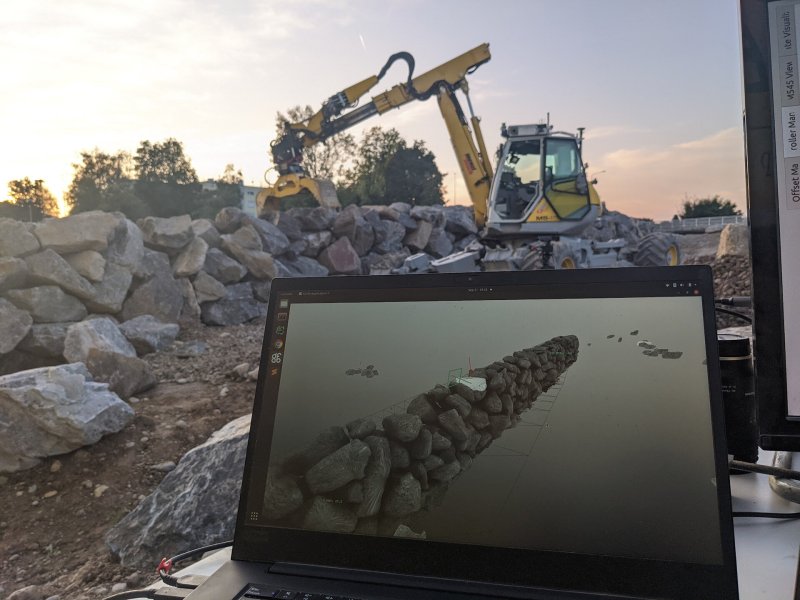
In a move that aims to further the circular economy of the construction industry, researchers at ETH Zurich have let an autonomous excavator loose on a big pile of boulders and reclaimed concrete. The goal? To build a 20 foot (6 meter) and 213 ft (65 m) long dry-stone wall as part of a park where the landscape was digitally planned, and the earth autonomously excavated.
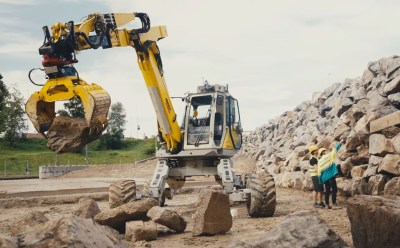 The coolest thing about the Menzi Muck excavator is the software, which is explored in the video after the break. Thanks to a bunch of sensors, the excavator can not only draw a 3D map of the site, it can find in situ boulders dotting the landscape and incorporate them into the wall.
The coolest thing about the Menzi Muck excavator is the software, which is explored in the video after the break. Thanks to a bunch of sensors, the excavator can not only draw a 3D map of the site, it can find in situ boulders dotting the landscape and incorporate them into the wall.
Machine vision allows the excavator to grab the stones and assess their size and shape, as well as approximate their weight and center of gravity.
Then, an algorithm determines the best place for each stone and places them there without using mortar or cement. Menzi Muck is capable of number-crunching 20 to 30 stones at a time, which coincidentally is about the number in one delivery.
Want to build your own excavator? Check out this finely-detailed R/C excavator for top-notch inspiration.
Tagged autonomous vehicle, construction, construction equipment, excavator
Wednesday, November 29, 2023
HOW TO PACK A BACKPACK FOR HIKING by NINA GROOM
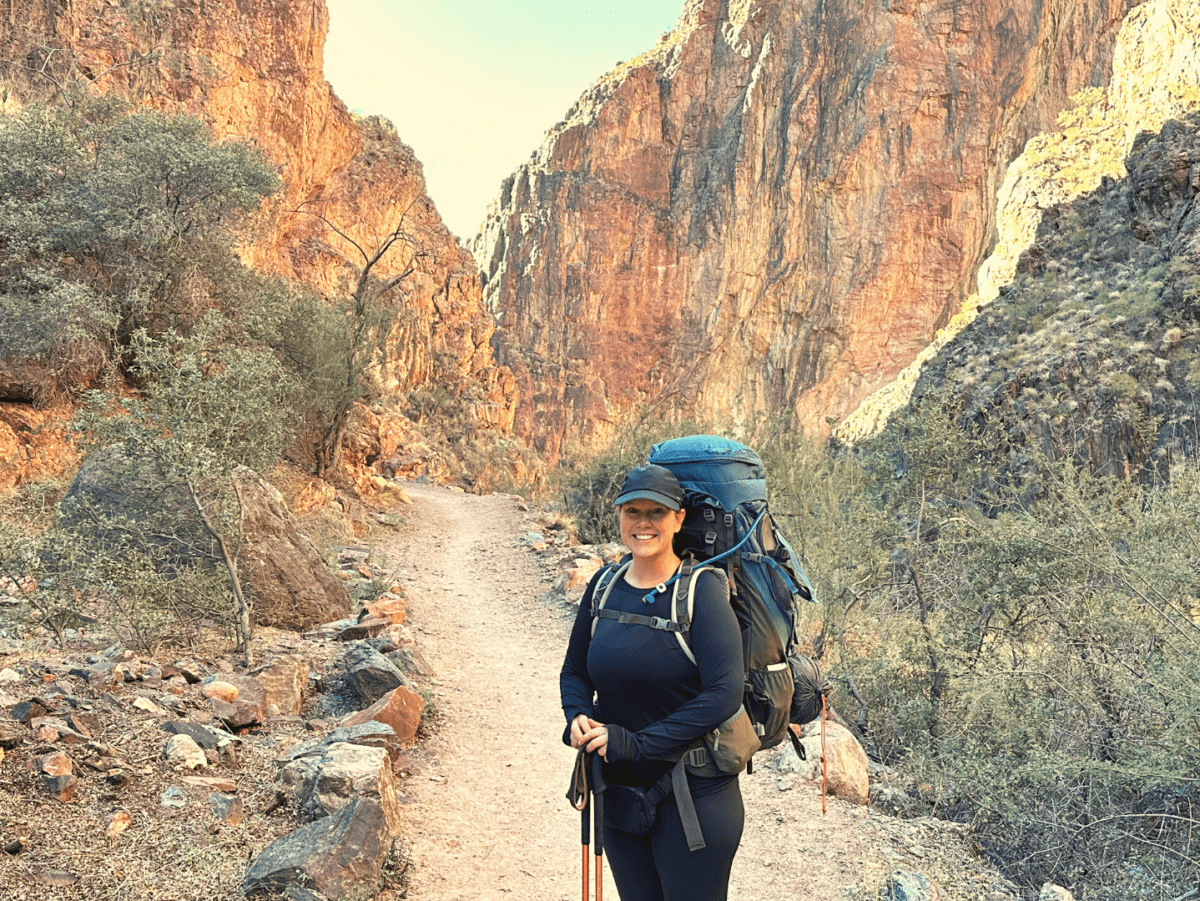
Flights are booked. Your guide is hired. All your last minute trip items have arrived in the mail with just moments to spare. You’ve prepared for everything…or just about everything. In the corner of your room still lies the big unknown: your backpack. Right now it is so approachable. So empty. Look at all those pockets, just waiting to be filled. It’s an exciting yet daunting prospect: in just a few short days you will fill this backpack with only the essentials and walk away from civilization.
My interest in backpacking doesn’t come from the prospect of sleeping under canopied forests or beneath towering canyon walls. Nor does it stem from the allure of total solitude or the promise of starry skies. What drew me in was the idea that I could be strong and capable enough to carry everything I needed to survive on my own back.
However, backpacking can quickly turn from a dream into a nightmare if not done correctly. To make the most out of your backpacking trip, it’s important to familiarize yourself with your supplies and understand how to prepare and pack your gear.
THE TEN ESSENTIALS
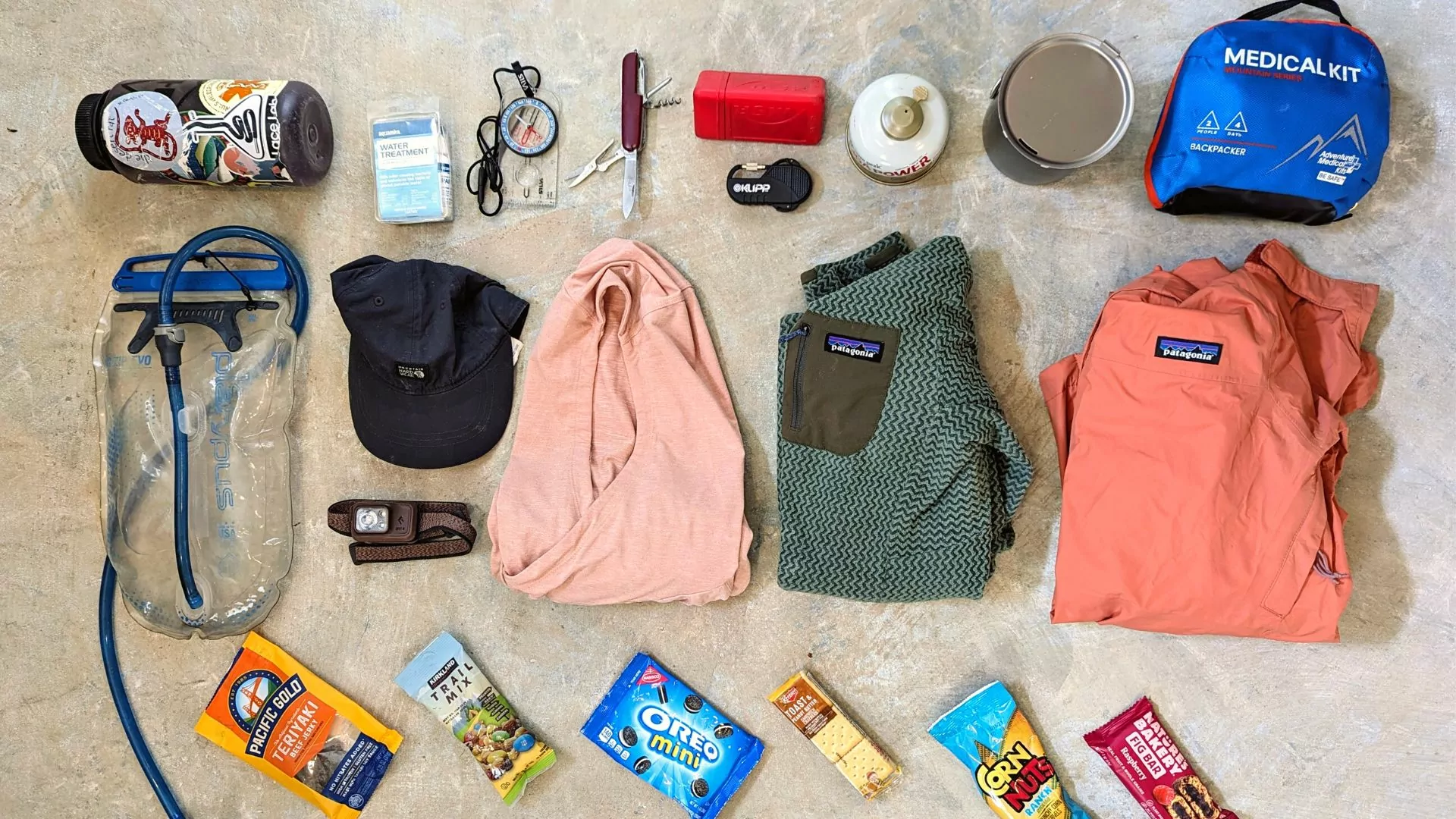 Every hike is different. Some are short and require minimal gear, while others require days or even weeks of planning. Despite the nature of your trip, consider the “ten essentials” when it comes to hiking.
Every hike is different. Some are short and require minimal gear, while others require days or even weeks of planning. Despite the nature of your trip, consider the “ten essentials” when it comes to hiking.
1. Navigation – There are a number of navigation systems that will help you plan and prepare for your trip. Common devices include a rechargeable GPS system or Satellite phone, a compass, and a topographical relief map.
Challenge yourself: Before your big adventure, try orienting yourself in your backyard or neighborhood with a compass and map.
2. Illumination – You will likely find yourself operating without a conventional light source on a backpacking trip. Lights with a strong LED bulb are essential in the backcountry whether it is a headlamp, flashlight, or lantern. Don’t forget extra batteries!
3. Sun Protections – Everyone loves a sunny day while backpacking, but too much sun can have devastating effects on the skin, eyes, and hydration levels. Protect yourself by packing lightweight layers, sunglasses, SPF (preferably one with a mineral base to protect wildlife), and a hat.
4. Insulation – Think beyond what you may typically sport for layers. Nature is unpredictable and your body may have trouble regulating when it is working hard. Depending on your location and time of year, prepare for the worst weather you could encounter.
Start by following a three-layer system: a thermal base layer, a mid-layer or fleece, and an insulated outer shell. Many adventurers will also include a puffy or insulated jacket in their arsenal. It’s important to know your body and recognize how well you regulate in extreme temperature fluctuations.
5. First Aid Supplies – Modify your First Aid Kit for each adventure. Do some research regarding FAK essentials (ace bandage, ibuprofen, a sterilization system) and build it up from there.
6. Fire Supplies – Not only will you need a lighter to ignite your camp stove, but you may need to create and maintain a fire for emergency situations. Consider bringing waterproof matches and a small fire starter to supplement your pocket lighters.
7. Repair Kit & Tools – Repair kits can often consist of common household items. Start collecting supplies that could be used in case of gear malfunction: duct tape, string, zip ties, and safety pins are a great place to start. In addition to your repair kit, travel with a small pocket knife or multitool.
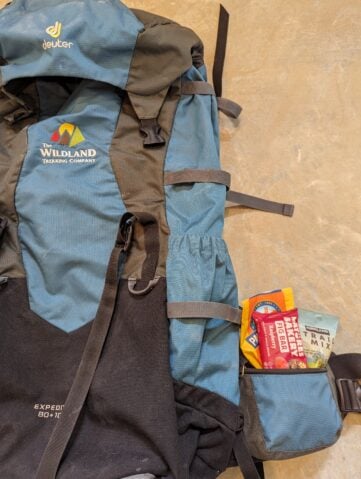 8. Nutrition – One of the best parts about hiking and backpacking is all the fun snacks you get to eat! It’s up to you to pack the right amount to keep your body fueled, as it is unlikely that food will be readily accessible on your trek (unless it’s berry season – free snacks!). Bring at least one extra day’s worth of food, should your trip take longer than expected. Salty and dehydrated foods make for great nutrition when hiking. Think dried fruit and nuts, granola bars, and jerky.
8. Nutrition – One of the best parts about hiking and backpacking is all the fun snacks you get to eat! It’s up to you to pack the right amount to keep your body fueled, as it is unlikely that food will be readily accessible on your trek (unless it’s berry season – free snacks!). Bring at least one extra day’s worth of food, should your trip take longer than expected. Salty and dehydrated foods make for great nutrition when hiking. Think dried fruit and nuts, granola bars, and jerky.
9. Hydration – Depending on the time of year and location of your trek, water can be a precious commodity. Get to know your water filter before you head out on your backcountry trip. There are dozens of water filtration systems that will vary greatly in weight, size, and efficiency, so do some research to decide which is the best for you. Bringing a vessel that can carry a minimum of 3-liters is advisable.
10. Emergency Shelter – Regardless of whether or not you are a minimalist camper, an emergency shelter is imperative to complete your backpacking kit. Choosing the right option here will also depend on how much weight you want to carry. Opt for tents weighing anywhere from 1 to 5 lbs, or skip the tent and carry a bivy sack, hammock, or space blanket. Whatever the right choice is for you, it’s important to prepare for extreme weather situations.
NON-ESSENTIALS/ MANAGING WEIGHT
In addition to the “ten essentials,” there are going to be extra supplies or “luxury items” that sneak into your pack. Remember that every ounce counts when backpacking, and those extra items will stack up quickly. Non-essential items may include camp shoes, a backpacking pillow or chair, a heavy camera, or books/notebooks. While one or two of these items may make it out on trail (I love a good pair of camp shoes on a backpacking trip), you will be a happier hiker without the additional weight, and it’s best to leave the majority of your “luxury items” at home.
Challenge yourself: Cut weight by leaving behind any fancier hygiene products such as soaps, deodorants, and face lotion. It’s okay to be a little smelly for a few days.
ABCS OF PACKING YOUR PACK
 Woah, that’s a lot of stuff! All those empty pockets on your pack may feel less approachable now, but never fear: follow the ABCs of packing your pack and you’ll be a pro in no time.
Woah, that’s a lot of stuff! All those empty pockets on your pack may feel less approachable now, but never fear: follow the ABCs of packing your pack and you’ll be a pro in no time.
A – ACCESSIBILITY
When loading items in your bag it’s best to think about how accessible you need an item to be throughout the day. For example, you won’t need any of your sleeping gear until you get to camp for the night, so items like your tent, sleeping pad, and sleeping bag can be situated near the bottom of your pack.
Items such as your rain jacket, water filter, map, sunscreen, and trail snacks may require immediate use throughout the day and should be stashed where they can be easily accessed. The brain (or the top lid that fits over the main compartment) is a great place to store items that will see a lot of use. Other easily accessed compartments include the side pockets or the mesh pouch on the outside of the pack.
B – BALANCE
Finding balance in your pack is arguably the toughest challenge when gearing up to hit the road. You want to keep in mind that your hip belt should be taking the majority of the weight, therefore, keep your heaviest items at your core. This includes your trail meals, tent, and other bulky miscellaneous items. Store your midweight items, like your sleeping bag, below the hip belt. When you are hiking, you shouldn’t feel any significant pulling or tugging from one single side. Check in with yourself and your muscles while on trail to ensure the weight is evenly distributed, and don’t be afraid to stop and make adjustments!
Challenge yourself: Stash all of your items into your backpack where you think they should go. Can your backpack stand up all on its own without tipping over? If so, nice work! That’s a pretty good indicator that your pack is well balanced.
C – COMPRESSION
The final component to the ultimate packing job is making your pack as compact as possible. Just like packing the trunk of your car or items into a suitcase, you want to make sure you are using every bit of space as efficiently as possible. Fill the spaces around larger items like your tent and sleeping bag with smaller, more malleable items like clothing. This stage in packing might feel like a workout in and of itself! By the end of it, your pack should feel like one large entity as opposed to many individual items. Don’t let empty spaces go unused.
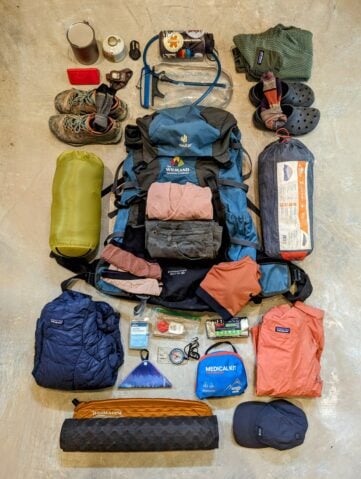 Challenge yourself: Shove your fist into your backpack and blindly feel around for empty pockets of space. Do your best to migrate items lower in your pack to fill all the holes. If you’re sweating, you’re doing it right!
Challenge yourself: Shove your fist into your backpack and blindly feel around for empty pockets of space. Do your best to migrate items lower in your pack to fill all the holes. If you’re sweating, you’re doing it right!
BEST BEGINNER BACKPACKING TRIPS
Packing the perfect backpack takes years of practice. Over time you will figure out what works and doesn’t work for you and your body. Investing in quality gear will help you cut weight and arranging your supplies will become more intuitive. The important thing is to not get frustrated. Take your time and adjust items when something feels wrong. You want to control your backpack, not have your pack control you. Practice at home before the big trip, and most importantly, have fun.
Merriam-Webster’s Word of the Year Reflects Growing Concerns Over AI’s Ability to Deceive By Roger J. Kreuz
When Merriam-Webster announced that its word of the year for 2023 was “authentic,” it did so with over a month to go in the calendar year.
Even then, the dictionary publisher was late to the game.
In a lexicographic form of Christmas creep, Collins English Dictionary announced its 2023 word of the year, “AI,” on October 31. Cambridge University Press followed suit on November 15 with “hallucinate,” a word used to refer to incorrect or misleading information provided by generative AI programs.
At any rate, terms related to artificial intelligence appear to rule the roost, with “authentic” also falling under that umbrella.
AI and the Authenticity Crisis
For the past 20 years, Merriam-Webster, the oldest dictionary publisher in the US, has chosen a word of the year—a term that encapsulates, in one form or another, the zeitgeist of that past year. In 2020, the word was “pandemic.” The next year’s winner? “Vaccine.”
“Authentic” is, at first glance, a little less obvious.
According to the publisher’s editor-at-large, Peter Sokolowski, 2023 represented “a kind of crisis of authenticity.” He added that the choice was also informed by the number of online users who looked up the word’s meaning throughout the year.
The word “authentic,” in the sense of something that is accurate or authoritative, has its roots in French and Latin. The Oxford English Dictionary has identified its usage in English as early as the late 14th century.
And yet the concept—particularly as it applies to human creations and human behavior—is slippery.
Is a photograph made from film more authentic than one made from a digital camera? Does an authentic scotch have to be made at a small-batch distillery in Scotland? When socializing, are you being authentic—or just plain rude—when you skirt niceties and small talk? Does being your authentic self mean pursuing something that feels natural, even at the expense of cultural or legal constraints?
The more you think about it, the more it seems like an ever-elusive ideal—one further complicated by advances in artificial intelligence.
How Much Human Touch?
Intelligence of the artificial variety—as in nonhuman, inauthentic, computer-generated intelligence—was the technology story of the past year.
At the end of 2022, OpenAI publicly released ChatGPT, a chatbot derived from so-called large language models. It was widely seen as a breakthrough in artificial intelligence, but its rapid adoption led to questions about the accuracy of its answers.
The chatbot also became popular among students, which compelled teachers to grapple with how to ensure their assignments weren’t being completed by ChatGPT.
Issues of authenticity have arisen in other areas as well. In November 2023, a track described as the “last Beatles song” was released. “Now and Then” is a compilation of music originally written and performed by John Lennon in the 1970s, with additional music recorded by the other band members in the 1990s. A machine learning algorithm was recently employed to separate Lennon’s vocals from his piano accompaniment, and this allowed a final version to be released.
But is it an authentic Beatles song? Not everyone is convinced.
Advances in technology have also allowed the manipulation of audio and video recordings. Referred to as “deepfakes,” such transformations can make it appear that a celebrity or a politician said something that they did not—a troubling prospect as the US heads into what is sure to be a contentious 2024 election season.
Writing for The Conversation in May 2023, education scholar Victor R. Lee explored the AI-fueled authenticity crisis.
Our judgments of authenticity are knee-jerk, he explained, honed over years of experience. Sure, occasionally we’re fooled, but our antennae are generally reliable. Generative AI short-circuits this cognitive framework.
“That’s because back when it took a lot of time to produce original new content, there was a general assumption … that it only could have been made by skilled individuals putting in a lot of effort and acting with the best of intentions,” he wrote.
“These are not safe assumptions anymore,” he added. “If it looks like a duck, walks like a duck, and quacks like a duck, everyone will need to consider that it may not have actually hatched from an egg.”
Though there seems to be a general understanding that human minds and human hands must play some role in creating something authentic or being authentic, authenticity has always been a difficult concept to define.
So it’s somewhat fitting that as our collective handle on reality has become ever more tenuous, an elusive word for an abstract ideal is Merriam-Webster’s word of the year.![]()
This article is republished from The Conversation under a Creative Commons license. Read the original article.
Image Credit: 愚木混株 cdd20 / Unsplash
